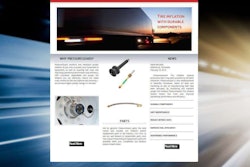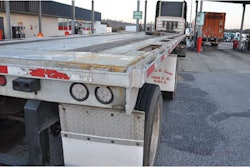State’s new regs, along with nationwide fuel prices, are driving sales of trailer aero devices.
For van trailer owners who run in California, the big one is coming Jan. 1, 2013. No, it’s not a forecast for the next major earthquake. It’s the date when all 53-foot or longer van trailers must outfit with aerodynamic equipment certified by the federal SmartWay Transport Partnership to improve fuel economy by at least 4 percent.
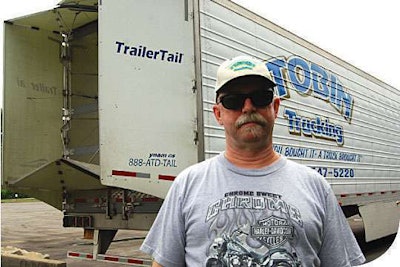 Brett Tobin says he’s increased his loaded mpg by at least 0.9 by adding a tail device and side skirts. He estimates he gets close to 12 mpg when deadheading.
Brett Tobin says he’s increased his loaded mpg by at least 0.9 by adding a tail device and side skirts. He estimates he gets close to 12 mpg when deadheading.Lavel Larson, leased to Valley Express of Fargo, N.D., couldn’t wait. He paid $44,000 on trade-in for a 2011 Great Dane reefer equipped with Freight Wing side skirts and wide single tires. He’d recently bought an aerodynamic 2011 Kenworth T700.
“I bought the trailer with the intention of putting on side skirts,” says Larson, of Battle Lake, Minn. “I needed the skirts to run in California, which is pretty much my regular run,” hauling grain products west and produce east.
The California Air Resources Board compliance date for 2011 dry van and reefer trailers was Jan. 1, 2010. “I still had another year on my old trailer (2005), but the CARB regulation was the other reason to update the reefer,” Larson says.
For owner-operators who work in California, the purchase of aerodynamic enhancements such as side skirts, trailer tails and front-end deflectors is a regulatory requirement. Beyond the 2013 date for dry vans, a series of compliance dates looms for reefer owners. Compliance is driving many owners to retrofit their trailers.
“What’s going to happen Jan. 1, 2013, when trailers can’t come into the state without skirts and low rolling resistance tires?” asks owner-operator Rob Fleig, who had a Nose Cone device installed on the front of his trailer. “It could be a line of trucks at the California state line stretching back to Oklahoma.”
“The California regulations originally drove a lot more attention to be paid to trailer aerodynamics,” says Andrew Smith, president of manufacturer ATDynamics, “but now the majority of our trucking company customers are all adopting the equipment well ahead of the California regulations.”
Big fleets have become major customers, says Brandon Pugh of Thermo King Northwest, which sells the Strehl Trailer Blade side skirt. “But when you get to the fleets of 25 to 30 trailers and down, there’s generally not as much knowledge about what the regs are.”
Freight Wing President Sean Graham says the appearance of more aerodynamic devices on trailers is persuading small fleets and owner-operators to inquire about them.
Fuel savings
Dealing with high fuel costs is the prime reason for owner-operators buying the Nose Cone, says Kathy Rose, Nose Cone vice president of sales and marketing. The device attaches to the front of the trailer and above the cab roof in mid-roof sleeper tractors.
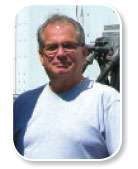 Rob Fleig returned his investment in a trailer Nose Cone at 35,000 miles, estimates the Nose Cone maker.
Rob Fleig returned his investment in a trailer Nose Cone at 35,000 miles, estimates the Nose Cone maker.“I don’t see the California regulations driving as much of that,” she says. “Fuel costs are driving it.”
Smith says that even operators who don’t own trailers are influencing the decision to add fuel-saving equipment. “We’ve seen that owner-operators will choose to pick up a load in an aerodynamic trailer as opposed to one that isn’t,” he says.
That’s the case with Jay Olmstead, who’s leased to LaValle Transportation of Potsdam, N.Y. The only trailer among the half-dozen in the LaValle fleet he will pull is one outfitted with an ATDynamics’ TrailerTail and side skirt.
“I told Randy [LaValle, company owner] I’m holding the trailer hostage. I used to drop and hook with other trailers, but this trailer has benefited me so much I don’t let anybody else touch it.”
 Lavel Larson estimates he’s improved his fuel economy by at least 0.5 mpg by using side skirts to reduce wind drag beneath the trailer.
Lavel Larson estimates he’s improved his fuel economy by at least 0.5 mpg by using side skirts to reduce wind drag beneath the trailer.Olmstead says he regularly records mpg of 7.75 and above pulling the trailer behind his high-mileage 1998 Freightliner Classic. He also attached Air Tab deflectors to the cab and shortened the gap between the cab and trailer. “I went from high 6s and low 7s to often above 8,” he says.
Olmstead estimates he saves $10,000 to $15,000 a year with the modifications.
Rate of payback
To qualify for the U.S. Environmental Protection Agency’s SmartWay-certified list of approved aerodynamic devices, a product must complete the SAE/TMC J1321 testing.
Though SmartWay lists minimum fuel savings, manufacturer testing can yield higher numbers, and a user’s actual fuel efficiency gain depends on wind, load weight and other factors. Those elements and your miles will determine how quickly you recoup your investment. For AeroFlex side skirts, Graham estimates: “At 100,000 miles a year and $4 a gallon fuel at 7 percent fuel efficiency, the payback is a little under four months.”
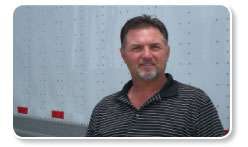 Buzz Lovelace says reducing his speed and installing a Nose Cone has raised his fuel economy by at least 0.5 mpg.
Buzz Lovelace says reducing his speed and installing a Nose Cone has raised his fuel economy by at least 0.5 mpg.Smith says the ATD TrailerTail tested at a fuel efficiency gain of 6.6 percent, while the Trailer Skirts’ posted gains in the 4-6 percent range. Each can deliver fuel savings of 0.3 to 0.4 mpg, he estimates.
Brett Tobin, an independent contractor from Medford, Ore., who runs under his own authority, estimates he returned the cost of the TrailerTail and side skirts in less than five months. He estimates a 0.9 mpg improvement. When he’s fully loaded hauling produce from California to Florida, he averages 6.75 mpg. When he deadheads, which is often, he gets 9.5 mpg or better.
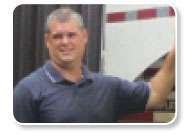 Jay Olmstead says if he has to give up his carrier’s only trailer equipped with an aero tail and under-trailer skirts, he’ll buy his own and outfit it with the fuel-saving attachments.
Jay Olmstead says if he has to give up his carrier’s only trailer equipped with an aero tail and under-trailer skirts, he’ll buy his own and outfit it with the fuel-saving attachments.“I do my own dispatch and look for high-mileage loads,” says Tobin, who usually runs at 55 mph. “It’s a good business decision. If I can save $600 to $900 on fuel a month, that’s a pretty good investment.”
Buzz Lovelace, leased to Landstar, paid $948 to have a Nose Cone with lights installed on his 2008 Stoughton 53-foot van in May. He estimates that reducing his average speed to 62 mph from 67 and adding the device, which includes side panels attached to the front of his trailer, has helped improve his fuel economy to 6.3 mpg from 5.5-5.8. He figures he saved $300 in fuel in the first month and a half. Rose, of Nose Cone, calculates Lovelace’s return on investment at just 17,000 miles.
Lovelace and Fleig didn’t consider side skirts because they each have a belly box carrying wrapping pads and a ramp rack for unloading trade show equipment and other special loads. “I did this for my own benefit,” says Pinson, Tenn.-based operator Lovelace, who is unfamiliar with the CARB regulations.
After procrastinating about adding a Nose Cone for years, Fleig finally paid $1,600 to install the product in May. After his initial fill-up and run with the new equipment, he logged 6.5 mpg.
“I was dumbfounded,” Fleig says. “I figured I’d be below 6. On my next fuel up I got 7.3 mpg. Since then I’ve been in the high 6s and low 7s.”
Rose estimated Fleig’s ROI after 35,000 miles. “I wish I had done it years ago,” says Lake Villa, Ill.-based Fleig, leased to Landstar.
For Larson, the combination of a new tractor and trailer has made a big difference. With the old tractor, he was getting 5.5-5.8 mpg. With the new truck, his fuel economy increased 0.5 mpg, and the trailer outfitted with aerodynamics improved it another 0.5. He estimates that 1 mpg improvement increases his profit by 12-14 cents a mile.
California regs for small fleets
California Air Resources Board regulations to reduce greenhouse gas emissions from trailers are divided by fleet size: those with 20 or fewer trailers and those with more than 20. Both groups can register with the state a schedule for bringing a percentage of their 2010 and older trailers into compliance each year.
The regs apply to all 53-foot or longer van and reefer trailers that operate in the state no matter where they are registered. On-highway tractors are also covered under the regulations for low rolling resistance tires.
All 2010 and older van trailers must be SmartWay-certified or retrofitted with aerodynamic technologies that produce at least a 4 percent fuel savings. Compliance is required by Jan. 1, 2013. In addition, those trailers must be outfitted with low rolling resistance tires by Jan. 1, 2017. For 2011 dry vans and reefers, the compliance date was Jan. 1, 2010.
Compliance dates vary for older reefers. For 2007-2009 reefers: Jan. 1, 2020; for 2005-2006: Jan. 1, 2019; and for 2003-2004: Jan. 1, 2018.
Owners of small fleets have the option of applying for a phase-in schedule for their 2010 and older trailers, which can range from 2014 to 2017. Owners must submit a compliance plan by July 1, 2012.
All 2010 and older sleeper and day cab tractors are required to have low rolling resistance tires by Jan. 1, 2013.
For more information, go to arb.ca.gov and search for “trailer,” or call the diesel hotline at (866) 634-3735.
Comparing the fuel savers
The following percentages indicate minimum fuel savings on aerodynamic technologies, according to third-party testing used by the U.S. Environmental Protection Agency’s SmartWay Transport Partnership. “Advanced” refers to later generation products that achieved 5 percent or better fuel savings without being used in combination with a gap fairing or tail device.
1% TRAILER GAP REDUCERS. Recommended to be used with side skirts. Products are the Carrier Transicold Gap Fairing, Freight Wing gap reducer, Laydon Composites gap reducer and Nose Cone’s 3-D gap reducer.
1% TRAILER BOAT TAIL. Recommended to be used with side skirts. Devices are the Aerodynamic Trailer Systems dual lobe boat tail, AeroVolution inflatable boat tail, ATS SmartTail and Transtex rear trailer fairing.
4% TRAILER SIDE SKIRTS. Recommended for use with a gap reducer or tail. Among the manufacturers are Carrier Transicold, Fleet Engineers, Freight Wing, Laydon Composites, Ridge Corp., Silver Eagle, Transtex and Utility Trailer.
5% ADVANCED TRAILER END FAIRINGS. Makers are ATDynamics, ATS and SmartTruck.
5% ADVANCED TRAILER SKIRTS. Makers are Aerofficient, Airflow Deflector, ATDynamics-Transtex, Atlantic Great Dane, Carrier Transicold, Freight Wing, Laydon Composites, Ridge Corp., Silver Eagle, Strehl, Sweet Bottom, Transtex, Utility Trailer, Wabash National and Windyne.
Reefer update schedule
Reefer owners who run in California face another set of deadlines, depending on the age of what the state calls transport refrigeration units.
California-based TRUs had to be registered with the state Air Resources Board by July 31, 2009, and the following month CARB staff began enforcement.
Beginning with 2001 model year reefer engines, CARB set deadlines for low-emission TRUs, followed by ultra-low-emission TRUs. Model year 2004 with 25 hp and greater must meet the standard by Dec. 31, and model year 2005’s deadline is Dec. 31, 2012.
For each year after that, add seven years to the TRU engine year to get the compliance year for that engine — for example, model year 2011 engine will be Dec. 31, 2018.

